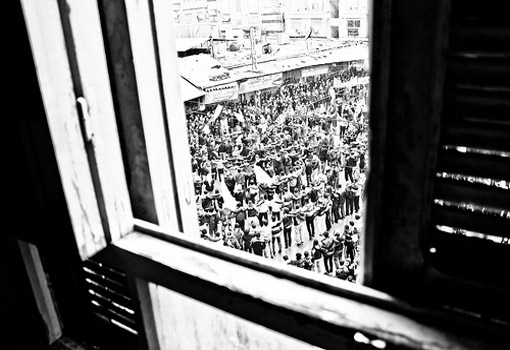
With the onset of the Syrian revolution, ordinary Syrians were suddenly acquainted with themselves through the very images they created with their own hands. This, after long decades during which the authorities had monopolized both the right to speak in their name and the right to create the image it wanted of and for them. At first, Syrians took to the streets armed only with the cameras of their mobile phones, even recording their own deaths at times in the belief that these images would force the world to bear watch and bear witness; would ultimately force the authorities to stop murdering them. But nothing of the kind happened. The crime was too great to be checked by mere images.
For 3 years straight Syrians persisted in their efforts to engage the world outside, sometimes speaking, sometimes screaming, into the camera’s lens; they did so in YouTube videos, before the lenses of foreign journalists and correspondents and in films and televised reports primarily centred around individual incidents. We were confronted by an endless stream of images and scenes, all trying in one great rush to convey something of the violence, torment and pain that Syrians—everywhere—are living through.
The image, in its creation, reception and interpretation, was at the heart of the Syrian revolution: creating events as it recorded them, consigning them to oblivion if it couldn’t. Between these two extremes the documentary film reclaimed its importance as a means of restoring to life the untold stories of those people who live the revolution just as much as they create it.
This multi-layered and complex relationship between the revolution and its image presented a number of challenges to a younger generation of aspiring documentary filmmakers, In Syria in particular and in the region in general. They were being asked to make films whose questions and concerns reflected their generation, with little connection either to the stereotyped images peddled by global media outlets and televised news broadcasts, or to the obsession with images of death and destruction that so dominated and obscured the wider landscape of life, resistance, work and art.
IN BRIEF
Bidayyat for Audiovisual Arts is a civil company, launched in early 2013, to support and produce documentaries and short and experimental films, and to organize specialized training courses on documentary filmmaking.
OUR UNDERSTANDING
We live today in an age in which the experience of the region has been recoupled to history, has diversified and fragmented, an age in which the peolple have barely begun to reacquaint themselves with their geographical, social and human topography. This is where Bidayyat comes in, an organization from the non-mainstream arts scene, preoccupied by troubling questions concerning the field of documentary filmmaking and uninterested in assumptions and pattern answers.
It is no longer enough to claim to be objectively documenting reality and conveying it meticulously and professionally to your audience; now, anyone who wishes to make documentary films is obliged to have a viewpoint; to interrogate their relationship with reality in an effort to invoke that reality from their own perspective. They must have something complex to say, someone to say it to, and they must know the most appropriate artistic form in which to say it.
In documentary filmmaking the only objectivity is that which takes the director’s presence and perspective into account. Objectivity means being aware that truth lies in a plurality of perspectives and their compatibility. Objectivity is respecting the characters in the film, their stories and their personal concerns. Objectivity is located in integrity, in the narrative’s aesthetic, in the power of the dramatic structure and in the coherence of the artistic vision. The story remains incomplete without the presence of the director, without a treatment that locates the work in time and place, without manipulation of sound and picture, without intensive work on the composition and editing. The story remains incomplete if the audience cannot play a role, is not free to read and interpret documentary films unhindered by prescriptive and patronising advice.
OUR VISION
Bidayyat envisions a creative, independent, open and interactive cinematic and audiovisual culture that is influential in our societies and is open to other societies.
- Bidayyat envisions becoming part of a cinematic movement that will give voice to the new experiments and artistic outpourings that the cultural scene is witnessing in this time of great change in the region.
- The emergence of a youthful visual language which connects with the experiences of a generation of pioneers in the field of documentary filmmaking, even as it forges a personal language that springs from the massive changes the arab revolutions has forced on the concept of the image and its use, not to mention the rise of digital technology, social networking sites and the Internet and the democratization they have introduced to the creation and reception of the image.
OUR GOAL
Bidayyat aims to be a space for the exchange of expertise and interaction between young people interested in documentary and short and experimental filmmaking, with the ultimate objective of creating a cultural and cinematic space. This space will offer artistic and professional support, as well as financial aid to help make their film projects a reality.
Ultimately, Bidayyat hopes to cast light on the complexity and richness of the region's sociological reality through a language of documentary cinema which interrogates reality just as much as it records it, which privileges art over propaganda, people over rulers and revolution over the status quo

